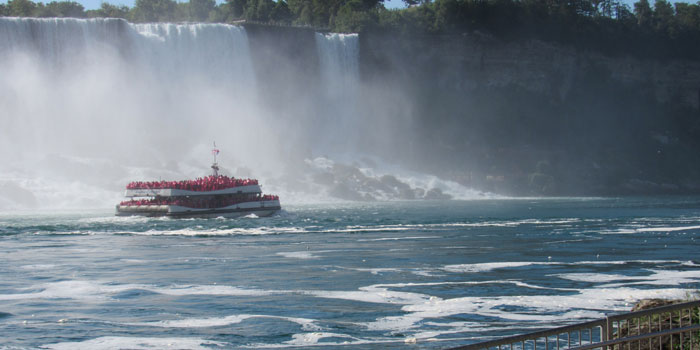Niagara Falls — Still A Great Wonder Of The World

A double-deck tour boat edges within 50 yards of the bottom of the Horseshoe Falls. More than 3 million visitors come to Niagara Falls every year.
Text and Photos
By Rod King
Guest Columnist
Niagara Falls is literally being eaten away by the forces of erosion. But don’t panic. You needn’t rush off to see the falls before they disappear, because it’s going to take a long time. So, the falls will still be around for spectacular views and an exciting experience whether you visit this summer or 10 years from now.
The falls straddle the U.S. and Canadian border where the Niagara River plunges over a 170-foot-tall cliff, smashing into the rocks below and creating an enormous mist cloud. The best view of the tremendous power of the cascading water is right at the bottom, up close and personal, where it hits the rocks.
People can do that by purchasing a ticket and walking down or taking the elevator to the bottom of the gorge where double-deck boats are moored. Depending on whether a boat sails from the Canadian side (“Voyage to the Falls”) or the American side (“Maid of the Mist”) determines the color of the plastic rain poncho that comes with the price of a ticket. Red is Canadian and blue is American. You’ll need it. The mist totally envelops the boat, which edges within 50 yards. The noise of 600,000 gallons of water per second coming over the falls and crashing on the rocks is deafening.
If you decide to stay dry and view the falls from afar, the best views are from Queen Victoria Park on the Canadian side. In fact, the Horseshoe, Bridal Veil and American Falls can be seen from the visitor’s center and park. The Horseshoe Falls are by far the most spectacular. Water going over the falls is extremely clean because there’s no sediment, which contributes to its overall beauty.
From the American side, visitors can get up close and personal to the falls by crossing a bridge to Goat Island, which separates Horseshoe Falls from Bridal Veil and American Falls. The Hurricane observation deck is perched between the Bridal and American Falls and affords a great view.
Another way to experience them is the Cave of the Winds at the bottom of American Falls. The volume of water passing over the two smaller falls is 150,000 gallons per second.
Niagara Falls is not the highest in the world by a long shot. At 170 feet tall, it’s not even in the top 500. Angel Falls in Venezuela is the highest at 3,212 feet.
During the past 560 years, the rate of recession was estimated at 1 to 1 1/2 meters per year. The current rate is about 1 foot per year, and utilizing flow control it may be reduced to 1 foot in 10 years. Upriver from the falls are four huge tunnels that divert water to power plants downstream. This has greatly reduced the amount of the erosion at the falls. During tourist hours in the summer months, however, the flow is maintained at a high level so visitors can enjoy the beauty and uniqueness of this physical phenomenon.
The force of the water will mean the eventual demise of the American Falls in approximately 2,000 years. Horseshoe Falls, on the other hand, will recede about 4 miles in the next 15,000 years and could end up being a series of rapids.
- “Voyage to the Falls” boat glides past the American and Bridal Veil Falls on the American side of the gorge. Visitors can walk out to Goat Island for a close look from the top of the falls. Cave of the Winds under the American Falls gives a close-up look at the power of the water coming over the falls.
- A red Canadian tour boat edges toward Horseshoe Falls, while a blue American tour boat heads back to the pier.
- By far the most spectacular of the falls, Horseshoe Falls is 2,600 feet from side to side. Erosion has caused the falls to recede 7 miles over the past 12,500 years.
- Passengers in red plastic ponchos peer through the mist at the falls. A total of 600,000 gallons of water pours over the falls every second. The mist caused by the water smashing on the rocks totally envelopes the boat and is deafening.




